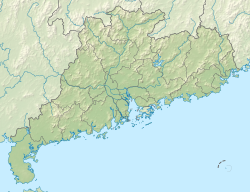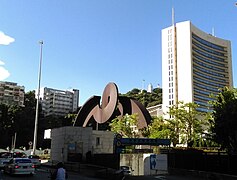Historic Centre of Macau
| UNESCO World Heritage Site | |
|---|---|
 Ruins of St. Paul's in Macau (Zone 1) | |
| Location | Macau, People's Republic of China |
| Includes |
|
| Criteria | Cultural: (ii), (iii), (iv), (vi) |
| Reference | 1110 |
| Inscription | 2005 (29th Session) |
| Area | 16.1678 ha (39.952 acres) |
| Buffer zone | 106.791 ha (263.89 acres) |
| Coordinates | 22°11′28.65″N 113°32′11.26″E / 22.1912917°N 113.5364611°E |
Location of Macau adjacent to Guangdong | |
The Historic Centre of Macao (Portuguese: Centro Histórico de Macau, Chinese: 澳門歷史城區) is a collection of over twenty locations that witness the unique assimilation and co-existence of Chinese and Portuguese cultures in Macau, a former Portuguese colony. It represents the architectural legacies of the city's cultural heritage, including monuments such as urban squares, streetscapes, churches and temples.
In 2005 the Historic Centre of Macau was inscribed on the UNESCO World Heritage List, making it the 31st designated World Heritage Site in China. It was described by UNESCO as: "with its historic street, residential, religious and public Portuguese and Chinese buildings, the historic centre of Macao provides a unique testimony to the meeting of aesthetic, cultural, architectural and technological influences from East and West," and "...it bears witness to one of the earliest and longest-lasting encounters between China and the West, based on the vibrancy of international trade."[1]

List of sites
[edit]The Historic Centre of Macao[2] is made up of two separated core zones in city centre on the Macau peninsula. Each core zone is surrounded by a buffer zone.[3]
Zone 1
[edit]The narrow-stripped Zone 1 is located between Mount Hill and Barra Hill.[4]
Buildings
[edit]| Name | Location | Notes | References | Photo | |
|---|---|---|---|---|---|
| A-Ma Temple | Barra Square |
Built in 1488, the temple is dedicated to Matsu, the goddess of seafarers and fishermen. The name Macau is thought to be derived from the name of the temple. |  | ||
| Moorish Barracks |  | ||||
| Mandarin's House |  | ||||
| St Lawrence's Church | 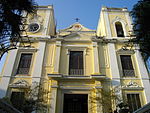 | ||||
| St. Joseph's Seminary and Church | 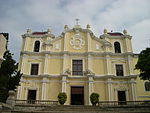 | ||||
| Dom Pedro V Theatre | St. Augustine's Square | 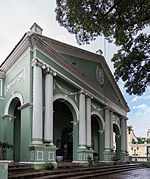 | |||
| Sir Robert Ho Tung Library | St. Augustine's Square |  | |||
| St. Augustine's Church | 3 St. Augustine's Square |  | |||
| Leal Senado Building | Senado Square | 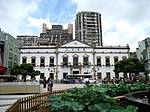 | |||
| Sam Kai Vui Kun (Kuan Tai Temple) |
10 Rua Sul do Mercado de São Domingos |  | |||
| Holy House of Mercy | Senado Square |  |
|||
| Cathedral of the Nativity of Our Lady |  |
||||
| Lou Kau Mansion | 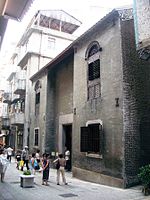 | ||||
| St. Dominic's Church | St. Dominic's Square |  | |||
| Ruins of St. Paul's |  | ||||
| Na Tcha Temple | 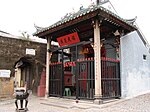 | ||||
| Section of the Old City Walls |  | ||||
| Monte Forte |  | ||||
| St. Anthony's Church |  | ||||
| Casa Garden | 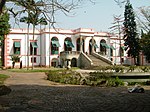 | ||||
| Old Protestant Cemetery and the old headquarters of the British East India Company[3] | 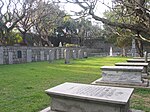 |
Squares
[edit]| Name | Location | Notes | References | Photo |
|---|---|---|---|---|
| Barra Square 媽閣廟前地 Largo do Pagode da Barra |
||||
| Lilau Square 亞婆井前地 |
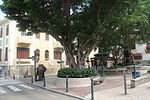 | |||
| St. Augustine's Square 崗頂前地 |
 | |||
| Senado Square 議事亭前地 |
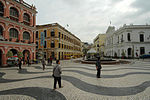 | |||
| St. Dominic's Square 板樟堂前地 |
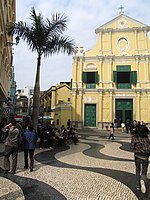 | |||
| Cathedral Square 大堂前地 |
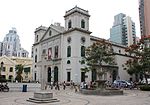 | |||
| Company of Jesus Square 耶穌會紀念廣場 |
The square in front of the Ruins of St. Paul's. |  | ||
| Camoes Square 白鴿巢前地 |
 |
Zone 2
[edit]The Zone is surrounded by a buffer zone that covers a park and immediate urban area.[3]
- Guia Fortress incorporating Guia Chapel and Guia Lighthouse
Management
[edit]Most of the items (buildings) are owned by the Macau Special Administrative Region (SAR) and managed by various departments or authority. Cultural Affairs Bureau of the SAR Government manages the Mandarin's House, the Ruins of St. Paul's, the Section of the Old Wall, Mount Fortress and Guia Fortress (includes the Lighthouse and Chapel).
Leal Senado Building is managed by the Municipal Affairs Bureau (IAM) while the two government-owned temples, A-Ma Temple and Na Tcha Temple are managed by the Board of A-Ma Temple Charity Association and management board of Na Tcha Temple respectively. The Moorish Barracks is managed by the Marine and Water Bureau.[5]
The rest of the items are owned and managed by the respective institutions. St. Joseph's Seminary Building and Church is owned by St. Joseph's Seminary and managed by the Catholic Diocese of Macao. The Holy House of Mercy Building is owned and managed by Holy House of Mercy Charitable Foundation. Dom Pedro V Theatre is owned and managed by the management board of Dom Pedro V Theatre.[5]
The nominated buildings of the Historic Centre are protected by various laws, including the Basic Law of the Macao SAR.[3]
Controversy
[edit]

In 2007, local residents of Macao wrote a letter to UNESCO complaining about construction projects around the World Heritage Site Guia Lighthouse (Focal height 108 meters), including the headquarter of the Macau Liaison Office (91 meters). UNESCO then issued a warning to the Macau government, which led former Chief Executive Edmund Ho to sign a notice regulating height restrictions on buildings around the site.[6]
In 2015, the New Macau Association submitted a report to UNESCO claiming that the government had failed to protect Macao's cultural heritage against threats by urban development projects. One of the main examples of the report is that the headquarters of the Liaison Office of the Central People's Government in the Macao Special Administrative Region, which is located on the Guia foothill and obstructs the view of the Guia Fortress (one of the world heritages symbols of Macao). One year later, Roni Amelan, a spokesman from UNESCO Press service, said that the UNESCO has asked China for information and is still waiting for a reply.[7][6]
In 2016, the Macau government approved an 81-meter construction limit for the residential project, which reportedly goes against the city's regulations on the height of buildings around the World Heritage Site Guia Lighthouse.[6]
Professor at Stanford University Dr. Ming K.Chan (Chinese: 陳明銶) and professor at University of Macau Dr. Eilo Yu (Chinese: 余永逸) commented the Guia Lighthouse case proved that the Macao government had ignored the conservation of heritage in urban planning.[8]
See also
[edit]References
[edit]- ^ Historic Centre of Macau. UNESCO World Heritage Centre
- ^ "Historic buildings". Retrieved 16 March 2021.
- ^ a b c d "Advisory Body Evaluation (of Historic Centre of Macao)" (PDF). UNESCO. 2005. Retrieved 2009-05-01.
- ^ The Map, Historic Centre of Macao
- ^ a b "Nomination file submitted to UNESCO" (PDF). UNESCO. 2005. Retrieved 2009-05-03.
- ^ a b c "New Macau alerts UN to construction project near lighthouse". Macau Daily Times. November 8, 2016.
- ^ Meneses, J. (2016). The Victory of Heritage. Macau Business, July 2016, pp.72-73.
- ^ YU, Eilo W.Y.; CHAN, Ming K. (2014). China's Macao Transformed: Challenge and Development in the 21st Century. City University of HK Press. p. 316. ISBN 978-9629372071.

